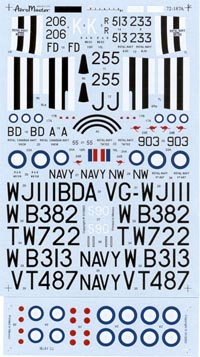 AeroMaster 1/72 Scale Fairey Firefly Pt.1 AeroMaster 1/72 Scale Fairey Firefly Pt.1
By Robert Allen One of the highlights of my first trip to England in 18 years, right up there with visiting Jane Austenís grave in Winchester Cathedral, was a full dayís visit to the Fleet Air Arm Museum at Yeovilton. If you ever get the chance to see the FAA Museum, by all means go Ė itís one of the worldís great aviation museums. And where else can you see a Flycatcher, Fulmar, Wyvern, or Albacore? Another unique opportunity is the chance to see early and late Fairey Fireflies sitting side-by-side. Seen close up, and with wings folded, the difference between the boxy chin radiator of the Mk.1 and the much sleeker profile of the Mk.4 and later series becomes clear. The later Fireflies were quite attractive aircraft, even if the role for which they were designed, that of a multi-seat fleet fighter/strike aircraft, was obsolescent by the time they entered service. Unfortunately, the mainstream producers of injected-molded kits seem to disagree Ė the late-model Firefly is represented by only one kit, the 1/72 scale Airfix Firefly Mk.V that first appeared in 1965. This is a typical Airfix offering of the period, marred by those legendary rivets and gimmicks, in this case rather unconvincing folding wings and moveable ailerons. On the plus side, itís really not that horrible a kit, and itís recently been reissued, so itís easy to find. Itís more accurate than the Battle or Defiant, and itís the only game in town. When I heard that AeroMaster was producing a decal sheet for this kit, I was rather incredulous. After all, itís not in 1/48th scale, and itís neither a Luftwaffe aircraft nor  a modern US jet. Still, miracles do happen, and this sheet is proof. a modern US jet. Still, miracles do happen, and this sheet is proof. Seven aircraft from three countries are included. Broken down by country, four British, two Australian, and one Canadian aircraft are given; by sub-type, thereís an FR.5, AS.6, TT.4, TT.6, U.9, and two AS.5. As the Firefly Mk.4/5/6/9 airframes were externally similar, thatís not as much of a problem as it might at first seem. What is a problem is that the differences between the subtypes are not spelled out in the decal instructions, though they are sometimes illustrated. The Airfix kit supplies parts for only the FR.5. The two target tugs require a winch to be added, and the U.9 drone needs the wingtip nacelles that carried recording equipment. Both of these would require some skill to correctly reproduce. The AS.6 carried no armament, so the wing cannons must be deleted from that aircraft, although the decal instructions show them fitted. The fuselage numbers given for the AS.6 also seem to be oversized. The decals appear to be up to AeroMasterís usual fine production standards, though Iím a bit leery of the roundels, which seem to be a bit dull, rather than the brighter post-war colors. A full set of Korean War recognition stripes is included for the one selection that needs them, and all the underwing serials are provided. Some will require careful cutting, as they bleed onto the undercarriage doors. (See photo above). Four of the aircraft are in Extra Dark Sea Grey and Sky (or Sky Grey in the case of the RCN aircraft). Three aircraft depart from the usual Firefly camouflage. The two target tugs have aluminum upper surfaces, and yellow and black undersurfaces. Even more striking is the RN U.9 drone, in Post Office Red and Deep Cream. That this sheet exists at all is wonderful. That it is labeled ďFirefly Pt 1Ē seems too good to be true. Whatís Pt 2 going to be Ė Ethiopian, Thai, and Danish Mk.1s? One can only hopeÖ References: *Warpaint No. 28: Fairey Firefly* by Geoffrey Bussy, Hall Park Books, 2001 *Scale Aircraft Modelling*, December 1984, "Aircraft in Detail: Fairey Firefly" by Alan W. Hale * Scale Aircraft Modelling*, April - May 1997, "Fairey Firefly: Under the Hood" (two parts) by Martin Hale *Fairey Aircraft since 1915*, by H. A. Taylor, Naval Institute Press, 1974, revised 1988 | 








|
 AeroMaster 1/72 Scale Fairey Firefly Pt.1
AeroMaster 1/72 Scale Fairey Firefly Pt.1 a modern US jet. Still, miracles do happen, and this sheet is proof.
a modern US jet. Still, miracles do happen, and this sheet is proof.






